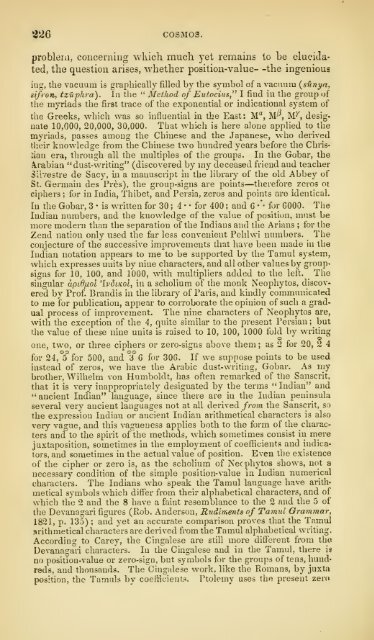See the complete document here
See the complete document here
See the complete document here
You also want an ePaper? Increase the reach of your titles
YUMPU automatically turns print PDFs into web optimized ePapers that Google loves.
326<br />
COSMOS.<br />
problem, concerning wkich much yet remains to be elucidated,<br />
<strong>the</strong> question arises, whe<strong>the</strong>r position-value-<br />
-<strong>the</strong> ingenious<br />
ing, <strong>the</strong> vacuum is graphically filled by <strong>the</strong> symbol of a vacuum {sunyn,<br />
sifron, tzuphra). lu <strong>the</strong> " Method of Eutocius,'^ I find in <strong>the</strong> group of<br />
<strong>the</strong> myriads <strong>the</strong> first trace of <strong>the</strong> exponential or indicational system of<br />
<strong>the</strong> Greeks, which was so influential in <strong>the</strong> East: M'', M^, M'^, designate<br />
10,000, 20,000, 30,000. That which is <strong>here</strong> alone applied to <strong>the</strong><br />
myriads, passes amoug <strong>the</strong> Chinese and <strong>the</strong> Japanese, who derived<br />
tlieir knowledge from <strong>the</strong> Chinese two hundred years before <strong>the</strong> Chnsdau<br />
era, through all <strong>the</strong> multiples of <strong>the</strong> groups. In <strong>the</strong> Gobar, <strong>the</strong><br />
\rabiau "dust-writing" (discovered by my deceased friend and teacher<br />
Silvestre de Sacy, m a manuscript in <strong>the</strong> libraiy of <strong>the</strong> old Abbey of<br />
St. Germain des Pres), <strong>the</strong> group-signs are points—<strong>the</strong>refore zeros oi<br />
for in India, Thibet, and Persia, zeros and points are identical.<br />
ciphers ;<br />
[u <strong>the</strong> Gobar, 3 • • •<br />
•*•<br />
is written for 30 ; 4 for 400 ; and G for GOOO. The<br />
Indian numbers, and <strong>the</strong> knowledge of <strong>the</strong> value of position, must be<br />
more modern than <strong>the</strong> separation of <strong>the</strong> Indians and <strong>the</strong> Arians ; for <strong>the</strong><br />
Zend nation only used <strong>the</strong> far less convenient Pehhvi numbers. The<br />
conjecture of <strong>the</strong> successive improvements that have been made in <strong>the</strong><br />
Indian notation appears to me to be supported by <strong>the</strong> Tamul system,<br />
which expresses units by nine characters, and all o<strong>the</strong>r values by groupsigns<br />
for 10, 100, and 1000, with multipliers added to <strong>the</strong> left. The<br />
singular upLdfcol 'Iv6lkoI, in a scholium of <strong>the</strong> monk Neophytos, discovered<br />
by Prof. Brandis in <strong>the</strong> library of Paris, and kindly communicated<br />
to me for publication, appear to corroborate <strong>the</strong> opinion of such a gradual<br />
process of improvement. The nine characters of Neophytos are,<br />
with <strong>the</strong> exception of <strong>the</strong> 4, quite similar to <strong>the</strong> present Persian; but<br />
<strong>the</strong> value of <strong>the</strong>se nine units is raised to 10, 100, 1000 fold by writing<br />
one, two, or three ciphers or zero-signs above <strong>the</strong>m; as 2 for 20, 2 4<br />
for 24, 5 for 500, and 3 G for 30G. If we suppose points to be used<br />
instead of zeros, we have <strong>the</strong> Arabic dust-writing, Gobar. As my<br />
bi-o<strong>the</strong>r, Wilhelm von Humboldt, has often remarked of <strong>the</strong> Sanscrit,<br />
that it is very inappropriately designated by <strong>the</strong> terms "Indian" and<br />
"<br />
ancient Indian" language, since <strong>the</strong>re are in <strong>the</strong> Indian peninsula<br />
several very ancient languages not at all derived from <strong>the</strong> Sanscrit, so<br />
<strong>the</strong> expression Indian or ancient Indian arithmetical characters is also<br />
very vague, and this vagueness applies both to <strong>the</strong> form of <strong>the</strong> characters<br />
and to <strong>the</strong> spirit of <strong>the</strong> methods, which sometimes consist in mere<br />
juxtaposition, sometimes in <strong>the</strong> employment of coefficients and indicators,<br />
and sometimes in <strong>the</strong> actual value of position. Even <strong>the</strong> existence<br />
of <strong>the</strong> cipher or zero is, as <strong>the</strong> scholium of Necphytos shows, not a<br />
in Indian numerical<br />
necessary condition of <strong>the</strong> simple position-value<br />
characters. The Indians who speak <strong>the</strong> Tamul language have arithmetical<br />
symbols which differ from <strong>the</strong>ir alphabetic-al characters, and of<br />
which <strong>the</strong> 2 and <strong>the</strong> 8 have a faint resemblance to <strong>the</strong> 2 and <strong>the</strong> 5 of<br />
<strong>the</strong> Devanagari figures (Rob. Anderson, Rudiments of Tamul Grammar,<br />
1821, p. 135) ; and yet an accurate comparison proves that <strong>the</strong> Tamul<br />
arithmetical characters are derived from <strong>the</strong> Tamul alphabetical writing.<br />
According to Carey, <strong>the</strong> Cingalese are still more different from <strong>the</strong><br />
Devanagari characters. lu <strong>the</strong> Cingalese and in <strong>the</strong> Tamul, <strong>the</strong>re is<br />
no position-value or zero-sign, but symbols for <strong>the</strong> groups of tens, hund*<br />
reds, and thousands. The Cingalese work, like <strong>the</strong> Romans, by juxta<br />
position, <strong>the</strong> Tamuls by coefficients. Ptolemy uses <strong>the</strong> present zero
















